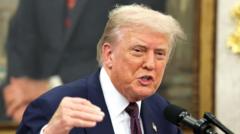U.S. President Donald Trump’s comprehensive new tariffs on a multitude of countries have officially taken effect, reshaping the landscape of international trade. Trump publicly announced the changes just minutes before the midnight deadline in Washington, D.C., stating, “IT'S MIDNIGHT!!! BILLIONS OF DOLLARS IN TARIFFS ARE NOW FLOWING INTO THE UNITED STATES OF AMERICA!”
Among the most significant measures is a staggering 50% tariff on products imported from India, set to commence on August 27, unless the country ceases its purchases of Russian oil. Additionally, Trump has threatened to impose a 100% tariff on foreign-manufactured computer chips as part of a broader appeal to tech companies to increase investments within the U.S.
Last week, the administration released a revised list of tariffs impacting various trading partners and extended the deadline for countries to negotiate with the U.S. to August 7. Countries are now scrambling to negotiate terms that could potentially lessen or eliminate these tariffs, which Trump has termed "reciprocal tariffs."
The implications of these tariffs are felt most acutely in export-driven economies in Southeast Asia, where manufacturing-centric nations like Laos and Myanmar face hefty levies of up to 40%. Analysts believe Trump has strategically targeted nations that are significantly linked to China in trade.
Meanwhile, several major economies—including the UK, Japan, and South Korea—have already managed to broker agreements that result in lower tariffs compared to those threatened previously. Furthermore, the European Union has reached a framework deal securing a 15% tariff rate on goods entering the U.S. from the bloc.
Taiwan, an important ally of the U.S. in Asia, has been assigned a 20% tariff. The Taiwanese president, Lai Ching-te, characterized the tariff as "temporary" and indicated ongoing negotiations to address the situation.
In another notable development last week, Trump increased the tariff on Canadian imports from 25% to 35%. He cited Canada’s failure to adequately cooperate in tackling the flow of fentanyl and other narcotics across the border. However, due to the existing United States-Mexico-Canada Agreement (USMCA), a majority of Canadian goods will be shielded from these tariffs.
The imposition of higher tariffs on Mexico has been postponed for an additional 90 days as trade talks remain in progress.
On Wednesday, Trump reiterated the potential for a 100% tariff on foreign-made semiconductors, though prominent chipmakers investing heavily in the U.S. appear to have circumvented this new levy with assertions from officials in Taiwan and South Korea regarding exemptions for companies such as TSMC, SK Hynix, and Samsung.
In response to the impending tariffs, many countries including India have voiced strong objections, with Indian officials denouncing the tariffs as "unfair, unjustified, and unreasonable," asserting their commitment to national interests. Brazilian exports to the U.S. now also face a new 50% tariff following accusations from Trump against President Luiz Inacio Lula da Silva regarding attacks on U.S. technology firms and political prosecutions.
As the U.S. and China engage in ongoing discussions to negotiate an extension of the current 90-day tariff suspension set to conclude on August 12, global businesses are processing the shockwaves that these tariffs are sending throughout the international trade community.





















